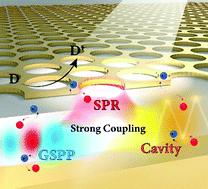Our official English website, www.x-mol.net, welcomes your feedback! (Note: you will need to create a separate account there.)
Enhancing plasmonic hot-carrier generation by strong coupling of multiple resonant modes
Nanoscale ( IF 6.7 ) Pub Date : 2020-12-28 , DOI: 10.1039/d0nr07643k Yat Lam Wong 1, 2, 3, 4 , Huaping Jia 1, 2, 3, 4, 5 , Aoqun Jian 4, 5, 6, 7, 8 , Dangyuan Lei 3, 4, 9, 10 , Abdel I. El Abed 11, 12, 13, 14, 15 , Xuming Zhang 1, 2, 3, 4
Nanoscale ( IF 6.7 ) Pub Date : 2020-12-28 , DOI: 10.1039/d0nr07643k Yat Lam Wong 1, 2, 3, 4 , Huaping Jia 1, 2, 3, 4, 5 , Aoqun Jian 4, 5, 6, 7, 8 , Dangyuan Lei 3, 4, 9, 10 , Abdel I. El Abed 11, 12, 13, 14, 15 , Xuming Zhang 1, 2, 3, 4
Affiliation

|
Plasmon-induced hot carriers have recently attracted considerable interest, but the energy efficiency in visible light is often low due to the short lifetime of hot carriers and the limited optical absorption of plasmonic architectures. To increase the generation of hot carriers, we propose to exert multiple plasmonic resonant modes and their strong coupling using a metal–dielectric–metal (MDM) nanocavity that comprises an Au nanohole array (AuNHA), a TiO2 thin film and an Au reflector. Unlike common MDM structures, in addition to the Fabry-Pérot mode in the dielectric layer, AuNHA as the top layer is special because it excites the localized surface plasmon resonance (LSPR) mode in the Au nanoholes and launches the gap surface plasmon polariton (GSPP) mode in the Au reflector surface. The spatial field overlapping of the three resonance modes enables strong mode coupling by optimizing the TiO2 thickness, which leads to notably enhanced average IPCE (∼1.5%) and broadband photocurrent (170 μA·cm−2). This MDM structure would be useful for photochemistry and photovoltaics using sunlight.
中文翻译:

通过多种共振模式的强耦合增强等离子体热载流子的产生
等离子体诱导的热载流子最近引起了极大的兴趣,但是由于热载流子的寿命短和等离激元结构的光吸收有限,可见光中的能量效率通常很低。为了增加热载流子的产生,我们建议使用包括金纳米孔阵列(AuNHA),TiO 2的金属-电介质-金属(MDM)纳米腔来施加多种等离子体共振模式及其强耦合。薄膜和金反射器。与普通的MDM结构不同,除了介电层中的Fabry-Pérot模式外,作为顶层的AuNHA还很特别,因为它可以激发Au纳米孔中的局部表面等离子体激元共振(LSPR)模式并发射间隙表面等离子体激元(GSPP) )模式在Au反射器表面上。通过优化TiO 2的厚度,三个共振模式的空间场重叠实现了强模式耦合,从而显着提高了平均IPCE(〜1.5%)和宽带光电流(170μA·cm -2)。这种MDM结构对于使用日光的光化学和光伏技术很有用。
更新日期:2021-01-25
中文翻译:

通过多种共振模式的强耦合增强等离子体热载流子的产生
等离子体诱导的热载流子最近引起了极大的兴趣,但是由于热载流子的寿命短和等离激元结构的光吸收有限,可见光中的能量效率通常很低。为了增加热载流子的产生,我们建议使用包括金纳米孔阵列(AuNHA),TiO 2的金属-电介质-金属(MDM)纳米腔来施加多种等离子体共振模式及其强耦合。薄膜和金反射器。与普通的MDM结构不同,除了介电层中的Fabry-Pérot模式外,作为顶层的AuNHA还很特别,因为它可以激发Au纳米孔中的局部表面等离子体激元共振(LSPR)模式并发射间隙表面等离子体激元(GSPP) )模式在Au反射器表面上。通过优化TiO 2的厚度,三个共振模式的空间场重叠实现了强模式耦合,从而显着提高了平均IPCE(〜1.5%)和宽带光电流(170μA·cm -2)。这种MDM结构对于使用日光的光化学和光伏技术很有用。

























 京公网安备 11010802027423号
京公网安备 11010802027423号